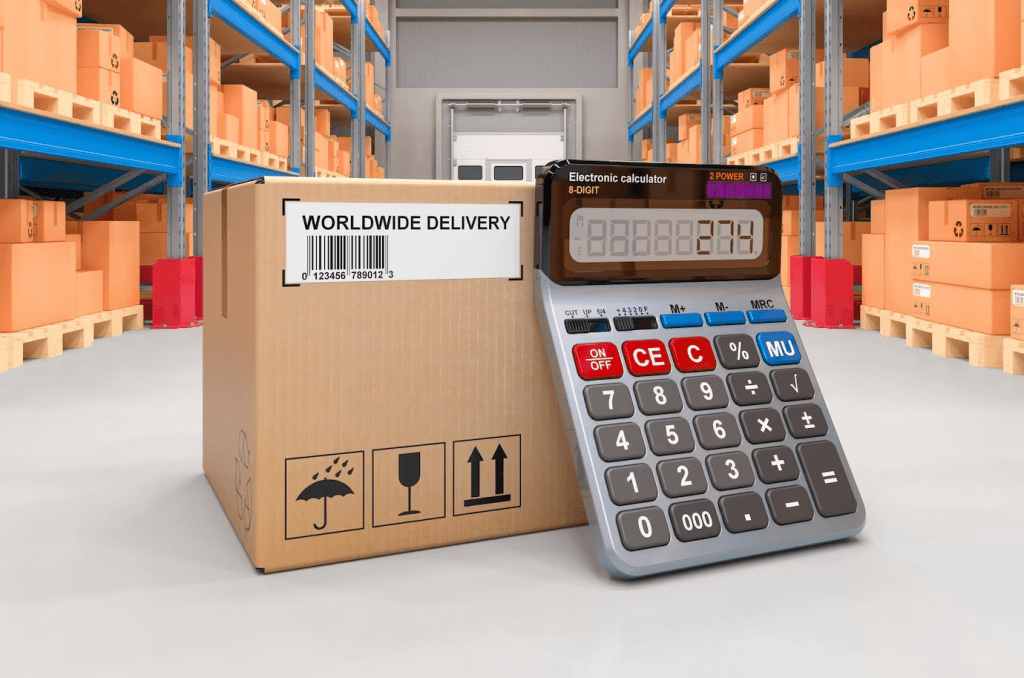The distinction between net weight vs gross weight is not about which is more crucial—they are both key measurements used for different purposes. Many of us have encountered these terms from a young age, yet there remains confusion about what they actually signify.
While these weights matter in everyday activities like shopping for groceries, they become critically important in the context of international logistics.

Table of Contents
ToggleImportance of Weights in International Shipping
In the realm of shipping and freight, accurately declaring the weight of consignments or containers is critical, forming a core part of the bill of lading documentation.
Any discrepancies in a container’s declared weight can lead to a myriad of problems, affecting not just logistics and costs but also the safety of crew members on board.
Strategic stowage is also essential for maintaining a vessel’s balance. For instance, consider two containers, “A” and “B,” where “A” weighs 25 tons and “B” weighs 27 tons.
To maintain stability, the lighter container “A” would be positioned above the heavier “B.”
Accurate weight measurements hold paramount importance for various critical aspects of shipping and logistics:
Determining Shipping Costs:
The cost of shipping is primarily influenced by the shipment’s weight, with heavier consignments typically incurring higher transportation fees. Precise calculations of net and gross weights are instrumental in ascertaining the right shipping costs. This accuracy prevents unexpected charges on invoices, enabling clearer financial planning and budgeting for shipping expenses.
Adherence to Legal and Safety Norms:
Transport entities are bound by stringent legal standards and safety protocols, dictating the maximum permissible cargo weight for safe transit. Accurately determining net, gross, and tare weights is vital for ensuring these carriers comply with regulatory mandates and uphold safety standards, safeguarding the well-being of their personnel and the integrity of the cargo.
Ensuring Customs Compliance:
In the context of international logistics, the precision of weight data is crucial for abiding by customs regulations. Disparities in declared and actual weights can trigger delays, impose penalties, or even result in the confiscation of goods. By meticulously calculating and declaring net and gross weights, shippers can facilitate more efficient customs processing, enhancing the predictability and reliability of international trade operations.
What Is Net Weight?

The term ‘net weight’ refers specifically to the weight of the actual product, excluding any packaging, containers, or additional materials used in shipping. In the context of maritime transport, it encapsulates the aggregate weight of the cargo alone, not accounting for the mass of the container, packaging materials, or any load-securing apparatus like pallets or strapping.
Here’s how to interpret with a practical scenario:
What Does Net Weight Mean
Imagine you’re a business in China exporting shoes. The weight of a single pair of shoes, devoid of any box or wrapping, is 1.14 kilograms (2.51 pounds). When dispatching a consignment of 2,000 pairs, the total net weight of your shoes would be 2,280 kilograms (5,026 pounds), which is the figure you’d declare as the shipment’s net weight, translating to 2.28 metric tons.
Calculating Net Weight Based on the Given Example
- Net weight = Total Quantity of Items x Individual Item Weight
- Net Weight = 2,000 pairs x 1.14 kg per pair
- Net Weight = 2,280 kilograms
What Is Gross Weight?
Understanding Gross Weight: An Example Explained
To delve deeper into what gross weight entails, let’s stick with our shoe exporter scenario. As established, each pair of shoes has a net weight of 1.14 kilograms, summing up to 2,280 kilograms for 2,000 pairs.
However, when we factor in packaging, the weight increases. Assume that each pair, along with its shoebox, dustbag, and paper envelope, weighs an additional 250 grams.
This adjustment bumps the weight of each pair up to 1.39 kilograms, culminating in a gross weight of 2,780 kilograms for all the pairs combined, which equates to 2.78 metric tonnes.Yet, we’re not done just yet.
You also need to account for the shelf or pallet used for shipment stabilization, which tips the scales at 600 kilograms. Plus, consider the 20-foot container itself, which adds another 1,800 kilograms when empty.
All told, the complete gross weight – encompassing the shoes, packaging, pallet, and container – escalates to 5,180 kilograms or 11,420 pounds, illustrating the critical distinction.
Calculating Gross Weight Based on the Provided Example
- Gross Weight = Net Weight + Packaging Weight + Shelf/Pallet Weight + Container Weight
- Gross Weight = 2,280 kg (net weight of shoes) + 500 kg (packaging for all pairs) + 600 kg (shelf or pallet) + 1,800 kg (empty container)
- Gross Weight = 5,180 kilograms
What Is Tare Weight?
The tare weight, often referred to as the “unladen weight,” signifies the weight of the container without any cargo inside. In our example of shoe exporting, the tare weight, adhering to international shipping norms, would solely be the 1,800 kilograms representing the empty container’s weight.
Understanding Actual Tare Weight vs. Average Tare Weight
The actual tare weight represents the real weight of an individual container without any contents, packaging, or pallets included. Conversely, the average tare weight is calculated by adding the tare weights of several containers and dividing the sum by the total number of those containers.
Let’s break this down using an example where you have six different containers, each with varying tare weights:
- Container A = 1,100 kilograms
- Container B = 1,200 kilograms
- Container C = 1,300 kilograms
- Container D = 2,100 kilograms
- Container E = 2,200 kilograms
- Container F = 2,300 kilograms
To find the total tare weight for all six containers, you would add up each container’s tare weight:
Total Tare Weight = 1,100 kg + 1,200 kg + 1,300 kg + 2,100 kg + 2,200 kg + 2,300 kg = 10,200 kilograms
To calculate the average tare weight, you then divide this total by the number of containers:
Average Tare Weight = Total Tare Weight ÷ Number of Containers = 10,200 kg ÷ 6 = 1,700 kilograms
This average tare weight can help you estimate container weights in situations where the actual tare isn’t provided.
Tare Weight Calculation Based on the Provided Example (Step-by-Step):
To ascertain the precise tare weight, you must undertake three meticulous steps:
Step 1: Calculate the Initial Tare Weight First, deduce the net weight from the gross weight to get an initial tare weight estimate.
- Tare weight = Gross weight (total weights combined) – Net weight (weight of the goods alone)
- Tare weight = (2,280 kg net weight + 500 kg packaging weight + 600 kg shelf weight + 1,800 kg container weight) – 2,280 kg net weight
Step 2: Consolidate Gross Weight Components Next, consolidate all elements contributing to the gross weight before subtraction.
- Tare weight = 2,280 kg + 500 kg + 600 kg + 1,800 kg – 2,280 kg (net weight)
- Tare weight = 5,180 kg (gross weight) – 2,280 kg (net weight)
- Tare weight = 2,900 kg
Step 3: Refine Tare Weight Lastly, extract the shelf weight and packaging weight from the preliminary tare weight to pinpoint the actual tare weight.
- Tare weight = 2,900 kg (from Step 2) – 600 kg (shelf weight) – 500 kg (packaging weight)
- Tare weight = 1,800 kg
These calculations adhere to the standard tare weight formula, which isolates the container’s weight by removing the net weight and additional content weights from the gross weight, offering a clear-cut method to determine just the container’s weight.
In practice, some logistics departments may reference the container’s tare weight directly from standardized records or assess the empty container’s weight independently before loading.
Following this, they sum the net weight and any additional weights (packaging, shelving) related to the consignment to ascertain the total gross weight, streamlining the calculation process for operational and planning accuracy in international shipping scenarios.
Formulas Of Net Weight vs Gross Weight, and Tare Weight

When delving into the details of cargo weights, the formulas for net weight, gross weight, and tare weight prove invaluable, especially when you’re starting with incomplete data and need to ascertain one value from the others. Here’s how you can apply these formulas effectively:
Net Weight Formula
To calculate the value when you already have the gross and tare weights:
- Net Weight = Gross Weight – Tare Weight
Gross Weight Formula
To find the gross weight when you have the net weight and tare weight at hand:
- Gross Weight = Net Weight + Tare Weight
Tare Weight Formula
To deduce the tare weight given the gross and net weights:
- Tare Weight = Gross Weight – Net Weight
If we revisit our shoe exporting scenario to apply these formulas, we can determine the respective weights accurately. For example, when considering that the gross weight includes the weight of the shoes plus any additional packing materials and the container itself:
- Gross Weight = Net Weight (shoes alone) + Tare Weight (container + additional packing)
- Gross Weight = 2,280 kg (net) + 1,800 kg (container) + 600 kg (shelves) + 500 kg (packing)
- Gross Weight = 5,180 kg
To find the specific tare weight excluding the net product weight:
- Tare Weight = Gross Weight – Net Weight
- Tare Weight = 5,180 kg – 2,280 kg
- Tare Weight = 2,900 kg
Lastly, to confirm the net weight:
- Net Weight = Gross Weight – Tare Weight
- Net Weight = 5,180 kg – 2,900 kg
- Net Weight = 2,280 kg
Understanding the distinctions and relationships between net weight vs. gross weight, along with tare weight, is vital within the logistics and shipping sectors.
The net weight provides insights into the actual product weight, while the gross weight encapsulates the total shipment weight.
Tare weight, pivotal for logistical accuracy, ensures correct billing, compliance with shipping regulations, and prevention of overloading, safeguarding both the shipment and personnel involved.
Net Weight vs Gross Weight: Key Differences
In the shipping realm, distinguishing between net weight and gross weight is crucial, as they serve different functions:
- Net weight refers to the weight of the goods only, while gross weight includes the weight of the goods, their packaging weight, and any additional accessories used for shipping.
- Net weight calculations are consistent across all modes of transport, whereas gross weight calculations may vary depending on the specific transportation method.
- Net weight does not include tare weight, while gross weight does.
Weight Declaration on Bills of Lading

Bills of lading play a pivotal role in the shipping industry, serving as official records that outline the specifics, quantities, and intended destinations of the items in transit.
Precise weight reporting on these documents is crucial for several key reasons:
- Facilitating correct handling and secure stowage of the cargo throughout its journey
- Adhering to global shipping standards and legal stipulations
- Determining the exact shipping fees
Typically, the gross weight of the cargo (encompassing both the goods and their packaging) is listed on the bill of lading.
Nonetheless, having a thorough understanding of both the net weight (weight of the goods alone) and tare weight (weight of the packaging or container) is vital for ensuring the accuracy of your shipping data and maintaining adherence to all pertinent shipping laws and guidelines.
Common Mistakes About Net Weight vs Gross Weight
Understanding the nuances between net weight and gross weight is crucial to avoid common pitfalls and misconceptions in their application:
Mixing Up Net Weight with Gross Weight
A common error is conflating net weight with gross weight, which can cause significant errors in shipping weight calculations. It’s vital to grasp that net weight denotes the actual weight of the products alone, whereas gross weight encompasses the weight of the products along with their packaging and any additional shipping materials.
Overlooking Tare Weight
Tare weight plays a fundamental role in determining the accurate net and gross weights. Neglecting to account for tare weight, which is the weight of the packaging or container itself, can skew the calculations, affecting logistics planning and regulatory compliance.
Utilizing Inaccurate Weighing Methods
Employing imprecise or non-calibrated scales can lead to miscalculated net and gross weights, potentially causing discrepancies in shipping costs and legal compliance issues. Ensuring that your weighing equipment is precise and up-to-date is imperative for accurate weight determination and avoiding operational hitches.
By sidestepping these common errors and adopting diligent measurement practices, you can enhance your logistical efficiency, ensure compliance with shipping regulations, and maintain the accuracy of your shipping cost calculations.
Tips for Accurate Weight Calculations
For precise weight measurements in your shipping operations, heed these essential guidelines:
Opt for Reliable and Calibrated Weighing Tools: Make sure you’re using equipment that’s known for its accuracy and is regularly calibrated to give you the correct figures for net weight, gross weight, and tare weight.
Conduct Regular Maintenance on Your Weighing Devices: Keep your scales in top-notch condition through consistent updates and maintenance checks to prevent any inaccuracies in weight measurements.
Accurately Label and Record Weights: It’s crucial to clearly mark and record the net weight, gross weight, and tare weight for every shipment, aiding in transparency and verification processes.
Educate Your Team on Weighing Protocols: Providing thorough training for your team on the appropriate methods for handling and weighing shipments can significantly improve the accuracy of your data.
Engage with Shipping Professionals: Collaborating with experienced freight forwarders and shipping consultants can help ensure your procedures align with global shipping standards and regulations, especially concerning net weight vs gross weight considerations.
By implementing these strategies, you can boost the reliability of your shipping weight data, streamline your logistics, and adhere to necessary international shipping guidelines.
Conclusion
Grasping the key differences between net weight and gross weight is crucial for any business involved in the logistics of shipping goods, whether on a local or global scale. Properly calculating and declaring these weights is vital for several reasons.
First, it aids in accurately determining shipping fees. Shipping costs are generally calculated based on the gross weight, which encompasses the actual product, its packaging, and any additional materials used for shipping. By accurately calculating the gross weight, businesses can avoid the pitfalls of under or overestimating their shipping costs.
Second, it ensures adherence to global shipping norms. Stringent weight regulations govern international trade, often focusing on the gross weight of shipments. Accurate weight declarations are necessary to prevent legal complications or fines stemming from non-compliance with these rules.
Third, it underscores the importance of safeguarding the cargo. Understanding both the net and gross weights is instrumental in selecting the appropriate transportation method and packaging materials, ensuring the cargo’s safety and integrity throughout its journey.
In the dynamic landscape of international commerce, proficiency in these weight calculations empowers businesses to optimize their logistics, comply with regulations, and enhance their competitive edge. A solid grasp of net weight vs. gross weight dynamics is indispensable for informed decision-making and fostering success in the intricate realm of shipping and supply chain management.
Partnering for Shipping Success

Forming strategic alliances can significantly streamline the intricacies of shipping logistics, particularly in the realm of weight management.
Engaging with seasoned shipping experts can offer invaluable insights into managing net weight, gross weight, and tare weight effectively. Collaborating with proficient freight forwarders and logistics specialists ensures your cargo is weighed accurately, documentation is thorough, and compliance with all pertinent regulations is met. This partnership approach can lead to optimized shipping costs, circumvention of potential complications, and bolstered success in the competitive domain of global shipping.
Additionally, integrating an ERP (Enterprise Resource Planning) system or contact with us, can revolutionize how you handle shipping weights. Such a system can meticulously track and record both net and gross weights and facilitate the accurate printing of these weights on product labels. Adopting an ERP solution equips businesses with the tools to monitor shipping metrics effectively, ensuring operational efficiency and regulatory adherence in their logistics processes.
